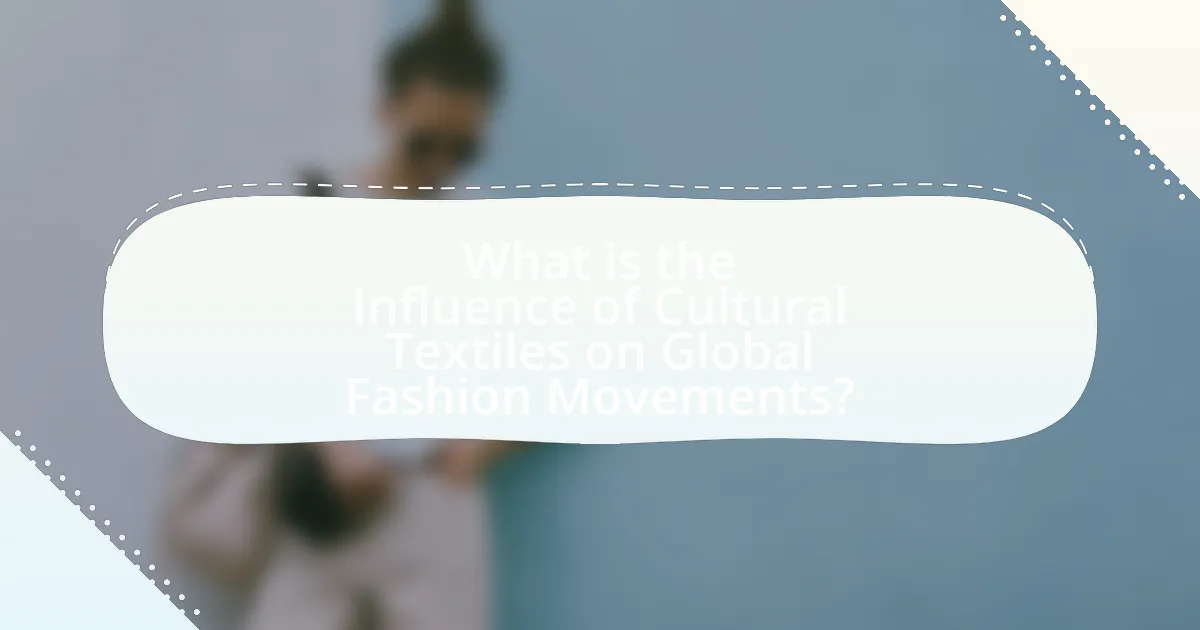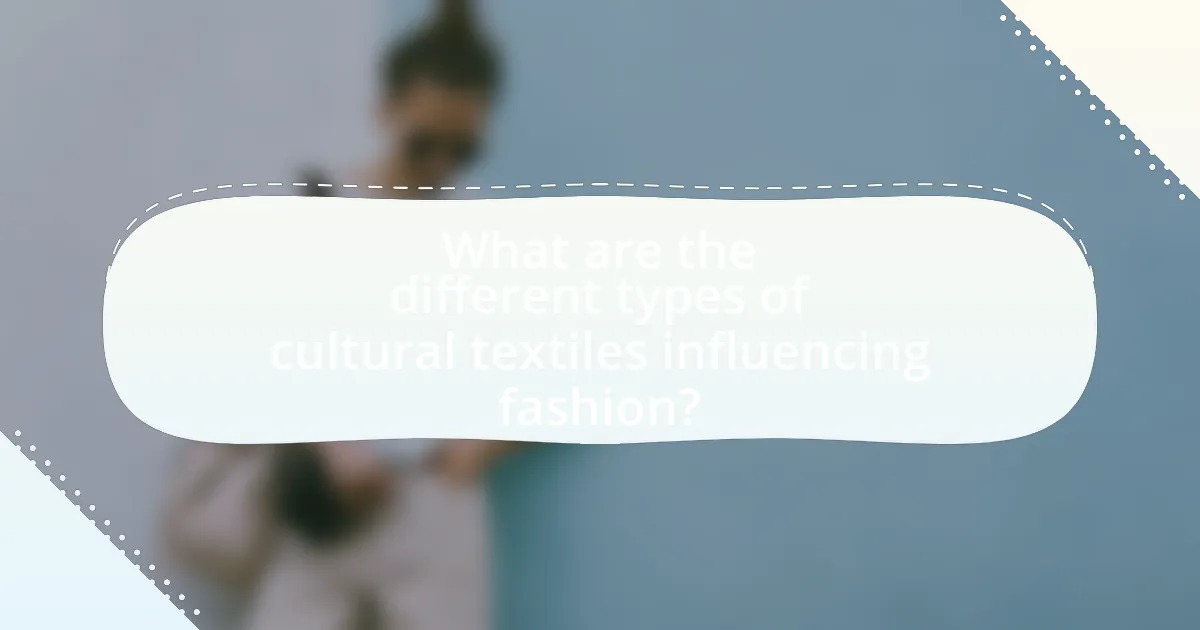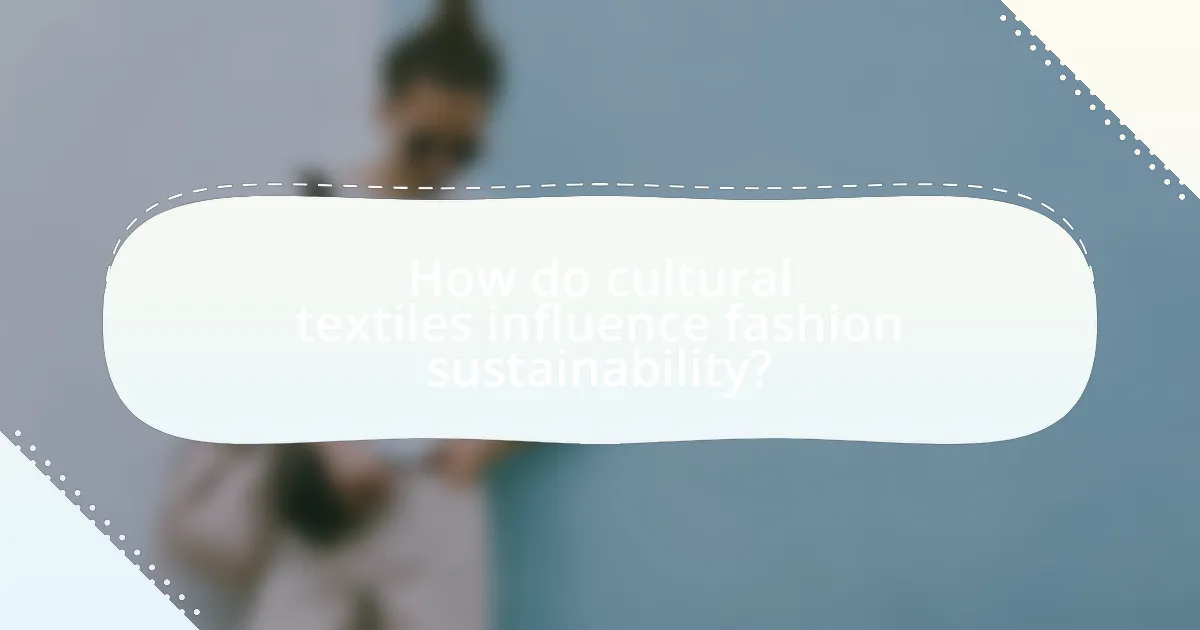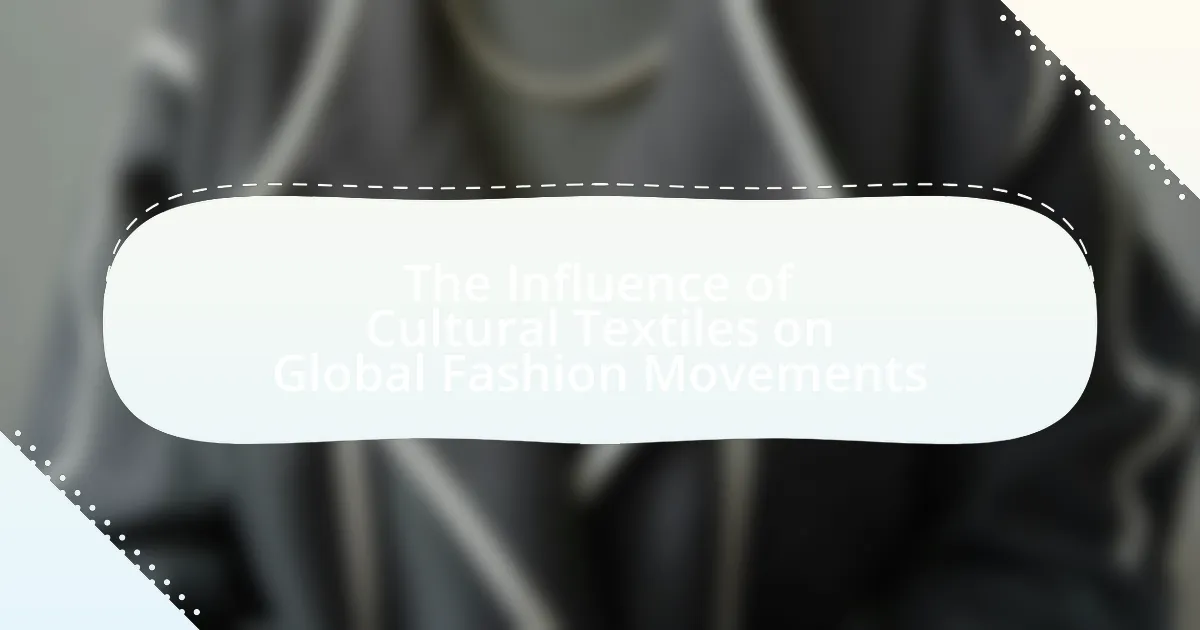Cultural textiles play a crucial role in shaping global fashion movements by introducing distinctive patterns, techniques, and materials that influence contemporary design. The article explores how traditional textiles, such as African kente cloth and Japanese kimono fabrics, inspire modern fashion trends and promote cross-cultural appreciation. It examines historical examples of cultural textiles’ impact on fashion, their reflection of societal values, and the challenges they face, including appropriation and sustainability issues. Additionally, the article highlights the significance of ethical practices in incorporating cultural textiles into fashion, the role of technology in their evolution, and future trends that emphasize sustainability and authenticity.

What is the Influence of Cultural Textiles on Global Fashion Movements?
Cultural textiles significantly influence global fashion movements by introducing unique patterns, techniques, and materials that shape contemporary design. For instance, the use of traditional African kente cloth has inspired numerous fashion designers, leading to the incorporation of vibrant colors and geometric patterns in modern collections. Additionally, the revival of Japanese kimono fabrics in Western fashion illustrates how cultural textiles can bridge diverse aesthetics, promoting cross-cultural appreciation. This influence is evidenced by the increasing presence of cultural motifs in high fashion, as seen in collections by brands like Gucci and Valentino, which often reference global textile traditions.
How do cultural textiles shape fashion trends worldwide?
Cultural textiles shape fashion trends worldwide by introducing unique patterns, colors, and techniques that influence designers and consumers alike. For instance, the use of traditional African kente cloth has inspired contemporary fashion collections, leading to a resurgence of vibrant colors and geometric designs in global apparel. Additionally, the incorporation of Japanese indigo dyeing techniques has impacted the denim industry, promoting sustainable practices and artisanal craftsmanship. These textiles not only reflect cultural heritage but also drive innovation in fashion, as seen in the growing popularity of ethnic prints and sustainable materials in mainstream fashion markets.
What historical examples illustrate the impact of cultural textiles on fashion?
Cultural textiles have significantly influenced fashion throughout history, with notable examples including the use of Indian cotton in British fashion during the 18th century and the adoption of Japanese kimono fabrics in Western haute couture. The British East India Company imported vast quantities of Indian cotton, which led to the popularity of muslin in Europe, shaping women’s fashion and contributing to the Industrial Revolution in textile manufacturing. Additionally, the introduction of kimono textiles, characterized by intricate patterns and vibrant colors, inspired designers like Paul Poiret in the early 20th century, who incorporated these elements into modern Western fashion, demonstrating the cross-cultural exchange that has shaped global fashion movements.
How do cultural textiles reflect societal values and beliefs in fashion?
Cultural textiles reflect societal values and beliefs in fashion by embodying the traditions, identities, and historical narratives of specific communities. For instance, the use of indigenous patterns in garments often signifies a connection to heritage and cultural pride, as seen in the vibrant textiles of the Andean communities, which convey stories of ancestry and social status. Additionally, textiles such as kente cloth from Ghana symbolize wealth and social prestige, illustrating how fabric choices can communicate societal hierarchies and values. The incorporation of these textiles into contemporary fashion not only preserves cultural significance but also challenges global fashion norms, promoting diversity and inclusivity.
Why are cultural textiles significant in the context of global fashion?
Cultural textiles are significant in the context of global fashion because they embody unique artistic expressions, historical narratives, and social identities that influence contemporary design. These textiles often incorporate traditional techniques and materials that reflect the heritage of specific cultures, making them valuable sources of inspiration for designers worldwide. For instance, the use of indigenous patterns and weaving methods can be seen in collections from major fashion houses, showcasing the integration of cultural elements into mainstream fashion. This blending not only promotes cultural appreciation but also drives economic opportunities for artisans and communities, as seen in the rise of ethical fashion brands that prioritize sustainable practices and fair trade.
What role do cultural textiles play in promoting diversity in fashion?
Cultural textiles play a crucial role in promoting diversity in fashion by introducing unique patterns, techniques, and narratives that reflect various cultural heritages. These textiles, such as African kente cloth, Indian saris, and Japanese kimono fabrics, not only enrich the aesthetic landscape of fashion but also foster inclusivity by celebrating different cultural identities. For instance, the incorporation of traditional weaving methods from indigenous communities into contemporary fashion collections has been shown to enhance cultural appreciation and awareness, as evidenced by brands like Stella McCartney and their collaborations with artisans worldwide. This blending of cultural textiles into mainstream fashion not only diversifies the offerings available to consumers but also encourages a dialogue about cultural significance and respect, thereby promoting a more inclusive fashion industry.
How do cultural textiles influence consumer behavior in the fashion industry?
Cultural textiles significantly influence consumer behavior in the fashion industry by shaping preferences, driving trends, and enhancing brand identity. For instance, textiles that reflect specific cultural heritage, such as African kente cloth or Japanese kimono fabrics, often evoke emotional connections and authenticity, leading consumers to favor brands that incorporate these elements. Research indicates that 70% of consumers are more likely to purchase products that resonate with their cultural identity, highlighting the importance of cultural textiles in marketing strategies. Additionally, brands that utilize cultural textiles can differentiate themselves in a saturated market, appealing to consumers’ desires for uniqueness and cultural appreciation.
What challenges do cultural textiles face in the global fashion market?
Cultural textiles face significant challenges in the global fashion market, primarily due to issues of appropriation, commercialization, and sustainability. Appropriation occurs when fashion brands use cultural textiles without proper acknowledgment or respect for their origins, leading to a loss of cultural significance. Commercialization often results in the mass production of these textiles, which can dilute their unique qualities and craftsmanship. Additionally, sustainability concerns arise as the demand for cultural textiles can lead to over-exploitation of resources and labor practices that do not support the communities that produce them. These challenges highlight the need for ethical practices and respect for cultural heritage in the fashion industry.
How does cultural appropriation affect the use of cultural textiles in fashion?
Cultural appropriation negatively impacts the use of cultural textiles in fashion by commodifying and misrepresenting the original cultural significance of these textiles. When designers use cultural textiles without understanding or respecting their origins, it can lead to a dilution of the cultural narratives and meanings associated with them. For instance, the use of traditional Indigenous patterns in mainstream fashion often occurs without acknowledgment of their historical context, which can perpetuate stereotypes and exploit marginalized communities. This appropriation can result in economic disadvantages for the original creators, as they may not benefit from the commercial success of their cultural expressions.
What are the implications of fast fashion on traditional textile practices?
Fast fashion significantly undermines traditional textile practices by promoting mass production and rapid consumption, which often leads to the decline of artisanal craftsmanship. Traditional textile practices, characterized by unique techniques and cultural significance, face threats as fast fashion prioritizes speed and cost over quality and heritage. For instance, the rise of synthetic materials in fast fashion diminishes the demand for natural fibers traditionally used in local textiles, resulting in the loss of skills and knowledge passed down through generations. Additionally, the environmental impact of fast fashion, including pollution and waste, further jeopardizes the sustainability of traditional textile practices, which often rely on eco-friendly methods. This shift not only affects artisans economically but also risks erasing cultural identities tied to these textile traditions.
How can we bridge the gap between cultural textiles and contemporary fashion?
To bridge the gap between cultural textiles and contemporary fashion, designers must incorporate traditional techniques and motifs into modern designs while respecting their cultural significance. This approach not only honors the heritage of the textiles but also creates unique, innovative pieces that resonate with contemporary consumers. For instance, brands like Stella McCartney and Etro have successfully integrated indigenous patterns and sustainable practices, demonstrating that cultural textiles can enhance modern aesthetics while promoting ethical fashion. By collaborating with artisans and communities, contemporary fashion can ensure authenticity and sustainability, fostering a deeper appreciation for cultural textiles in the global market.
What strategies can designers use to incorporate cultural textiles ethically?
Designers can incorporate cultural textiles ethically by engaging in collaborative partnerships with artisans from the respective cultures. This strategy ensures that the original creators are fairly compensated and involved in the design process, fostering respect and authenticity. For instance, brands like Stella McCartney have collaborated with indigenous communities to create collections that honor traditional techniques while providing economic support. Additionally, designers should prioritize transparency in sourcing materials, ensuring that the origins of textiles are clearly communicated to consumers. This practice not only builds trust but also educates the market about the cultural significance of the textiles used. Furthermore, designers can conduct thorough research to understand the cultural context and significance of the textiles, which helps avoid cultural appropriation and promotes cultural appreciation.

What are the different types of cultural textiles influencing fashion?
Different types of cultural textiles influencing fashion include ikat, batik, kente, and paisley. Ikat, originating from Indonesia and Central Asia, features a dyeing technique that creates intricate patterns, significantly impacting contemporary textile design. Batik, a traditional Indonesian method, uses wax-resist dyeing to produce detailed motifs, influencing global fashion through its vibrant colors and designs. Kente cloth, from Ghana, is known for its bright colors and geometric patterns, symbolizing cultural heritage and inspiring modern fashion collections. Paisley, with roots in Persian and Indian textiles, has become a staple in Western fashion, characterized by its teardrop-shaped motif, demonstrating the cross-cultural exchange in textile design. Each of these textiles not only reflects cultural significance but also shapes global fashion trends, showcasing the interconnectedness of cultural heritage and contemporary style.
How do traditional textiles from various cultures differ?
Traditional textiles from various cultures differ significantly in their materials, techniques, patterns, and cultural significance. For instance, Indian textiles often utilize cotton and silk, featuring intricate block printing and embroidery, while Andean textiles from Peru are known for their use of alpaca wool and vibrant geometric patterns that reflect indigenous heritage. African textiles, such as kente cloth from Ghana, are characterized by bold colors and symbolic designs, often woven from silk and cotton. These differences are rooted in the unique historical, environmental, and social contexts of each culture, influencing the choice of materials and the methods of production. The distinctiveness of each textile tradition not only showcases the artistry of the culture but also serves as a medium for storytelling and cultural identity.
What are the unique characteristics of African textiles in fashion?
African textiles in fashion are characterized by vibrant colors, intricate patterns, and diverse techniques that reflect cultural heritage. These textiles often utilize bold geometric designs and symbolic motifs, which convey stories and traditions specific to various ethnic groups. For instance, Kente cloth from Ghana is renowned for its bright colors and complex patterns, each representing different meanings and historical narratives. Additionally, the use of natural dyes and hand-weaving techniques showcases the craftsmanship and sustainability inherent in African textile production. This unique blend of artistry and cultural significance has influenced global fashion trends, as designers increasingly incorporate African textiles into contemporary collections, highlighting their rich history and aesthetic appeal.
How do Asian textiles contribute to global fashion aesthetics?
Asian textiles significantly contribute to global fashion aesthetics by introducing unique patterns, techniques, and materials that enhance design diversity. For instance, the intricate weaves of silk from China and the vibrant colors of Indian block prints have inspired numerous fashion designers worldwide, leading to the incorporation of these elements into contemporary collections. Historical evidence shows that the Silk Road facilitated the exchange of textiles, influencing European fashion in the 16th century, which established a long-standing appreciation for Asian craftsmanship. Additionally, the rise of sustainable fashion has led to a renewed interest in traditional Asian textile techniques, such as handloom weaving and natural dyeing, which are now celebrated for their environmental benefits and artisanal value.
What modern adaptations of cultural textiles are emerging in fashion?
Modern adaptations of cultural textiles in fashion include the integration of traditional patterns and techniques into contemporary designs, such as the use of African kente cloth in high-end streetwear and the incorporation of Japanese kimono fabrics in luxury apparel. Designers like Stella Jean and Issey Miyake have successfully blended these cultural elements, showcasing them on global runways. This trend reflects a growing appreciation for cultural heritage, as evidenced by the rise of brands that prioritize ethical sourcing and collaboration with indigenous artisans, thereby promoting sustainability and cultural preservation in the fashion industry.
How are designers innovating with traditional textile techniques?
Designers are innovating with traditional textile techniques by integrating modern technology and sustainable practices into their processes. For instance, the use of digital printing allows for intricate designs that were previously labor-intensive, while techniques like natural dyeing are being revived to promote eco-friendliness. Additionally, collaborations between artisans and contemporary designers are blending traditional craftsmanship with contemporary aesthetics, resulting in unique textile products that honor cultural heritage while appealing to modern consumers. This approach not only preserves traditional methods but also enhances their relevance in today’s fashion landscape, as seen in collections that feature handwoven fabrics combined with innovative silhouettes.
What role does technology play in the evolution of cultural textiles in fashion?
Technology significantly enhances the evolution of cultural textiles in fashion by enabling innovative production methods and facilitating global accessibility. Advanced techniques such as digital printing and 3D weaving allow designers to incorporate traditional patterns and materials into contemporary fashion, preserving cultural heritage while appealing to modern aesthetics. For instance, digital textile printing can replicate intricate designs from various cultures with precision, making it easier for fashion brands to integrate diverse cultural elements into their collections. Additionally, technology-driven platforms like e-commerce and social media have expanded the reach of cultural textiles, allowing artisans and designers from different backgrounds to showcase their work to a global audience, thus fostering cross-cultural exchange and collaboration.

How do cultural textiles influence fashion sustainability?
Cultural textiles significantly influence fashion sustainability by promoting traditional craftsmanship and eco-friendly practices. These textiles often utilize natural fibers and dyes, which reduce environmental impact compared to synthetic materials. For instance, the use of handwoven fabrics in regions like India and Peru not only supports local artisans but also encourages the preservation of cultural heritage. Studies show that sustainable fashion brands increasingly incorporate these textiles to appeal to environmentally conscious consumers, thereby driving a shift towards more sustainable production methods. This integration of cultural textiles into mainstream fashion helps to foster a circular economy, where resources are reused and waste is minimized, ultimately contributing to a more sustainable fashion industry.
What sustainable practices can be derived from traditional textile methods?
Sustainable practices derived from traditional textile methods include the use of natural dyes, hand-weaving techniques, and local sourcing of materials. Natural dyes, such as indigo and madder, minimize environmental impact by avoiding synthetic chemicals, which are harmful to ecosystems. Hand-weaving techniques promote craftsmanship and reduce reliance on mass production, leading to lower carbon footprints. Additionally, local sourcing of fibers, like cotton or wool, supports local economies and reduces transportation emissions. Historical evidence shows that many indigenous cultures have utilized these methods for centuries, demonstrating their effectiveness in promoting sustainability in textile production.
How do cultural textiles promote eco-friendly fashion choices?
Cultural textiles promote eco-friendly fashion choices by emphasizing traditional, sustainable practices and materials that minimize environmental impact. Many cultural textiles are crafted using natural fibers, such as cotton, wool, and silk, which are biodegradable and often produced with less harmful chemicals compared to synthetic alternatives. For instance, indigenous communities often utilize local resources and traditional dyeing techniques that avoid toxic substances, thereby reducing pollution. Additionally, the slow fashion movement, inspired by cultural textiles, encourages consumers to value quality and craftsmanship over fast fashion, leading to reduced waste and a lower carbon footprint. This approach is supported by studies showing that sustainable fashion practices can significantly decrease the environmental burden of the fashion industry.
What lessons can the fashion industry learn from traditional textile artisans?
The fashion industry can learn the importance of craftsmanship and sustainability from traditional textile artisans. Traditional artisans emphasize meticulous handwork and the use of locally sourced materials, which results in high-quality products that often have cultural significance. For example, the intricate weaving techniques of indigenous communities not only preserve cultural heritage but also promote sustainable practices by minimizing waste and utilizing natural dyes. This approach contrasts with fast fashion’s mass production model, which often prioritizes speed and cost over quality and environmental impact. By adopting these artisanal principles, the fashion industry can enhance its commitment to sustainability and cultural appreciation, ultimately leading to more responsible and meaningful fashion practices.
What are the future trends for cultural textiles in global fashion?
Future trends for cultural textiles in global fashion include increased sustainability, digital integration, and a focus on authenticity. Sustainability is becoming paramount as brands prioritize eco-friendly materials and ethical production methods, reflecting a growing consumer demand for responsible fashion. Digital integration involves the use of technology, such as augmented reality and blockchain, to enhance the storytelling of cultural textiles, allowing consumers to connect with the heritage behind the fabrics. Additionally, authenticity is gaining importance, with designers increasingly drawing inspiration from traditional techniques and local artisans, ensuring that cultural narratives are preserved and respected in contemporary fashion. These trends are supported by market research indicating that 66% of consumers are willing to pay more for sustainable brands, highlighting the shift towards responsible fashion choices.
How might globalization affect the preservation of cultural textiles?
Globalization may threaten the preservation of cultural textiles by promoting homogenization and mass production, which can overshadow traditional practices. As global markets expand, local artisans often face competition from cheaper, mass-produced alternatives that lack cultural significance. For instance, the rise of fast fashion has led to a decline in the demand for handmade textiles, as consumers prioritize affordability over authenticity. This shift can result in the loss of unique textile techniques and cultural heritage, as seen in regions where traditional weaving practices are being abandoned in favor of industrial methods.
What innovations are likely to emerge from the fusion of cultural textiles and modern fashion?
Innovations likely to emerge from the fusion of cultural textiles and modern fashion include sustainable materials, advanced textile technology, and unique design aesthetics. The integration of traditional techniques with contemporary practices can lead to eco-friendly fabrics that utilize natural dyes and organic fibers, reducing environmental impact. For instance, brands like Stella McCartney have successfully incorporated sustainable practices while drawing inspiration from cultural textiles. Additionally, the use of digital printing technology allows for intricate patterns and designs that reflect cultural heritage, enabling designers to create one-of-a-kind pieces that resonate with diverse audiences. This blend not only preserves cultural identities but also promotes inclusivity in fashion, as seen in collaborations between global designers and artisans from various cultural backgrounds.
What practical steps can consumers take to support cultural textiles in fashion?
Consumers can support cultural textiles in fashion by prioritizing purchases from brands that ethically source and promote traditional textiles. By choosing to buy from companies that collaborate with artisans and communities, consumers help sustain cultural heritage and provide fair wages. For instance, brands like Aakasha and Indego Africa directly support local artisans, ensuring that traditional techniques are preserved and valued. Additionally, consumers can educate themselves about the cultural significance of textiles, advocating for transparency in the fashion supply chain, which encourages brands to respect and honor cultural practices. Engaging in community events that celebrate cultural textiles, such as workshops or exhibitions, further amplifies awareness and appreciation for these art forms.

Leave a Reply